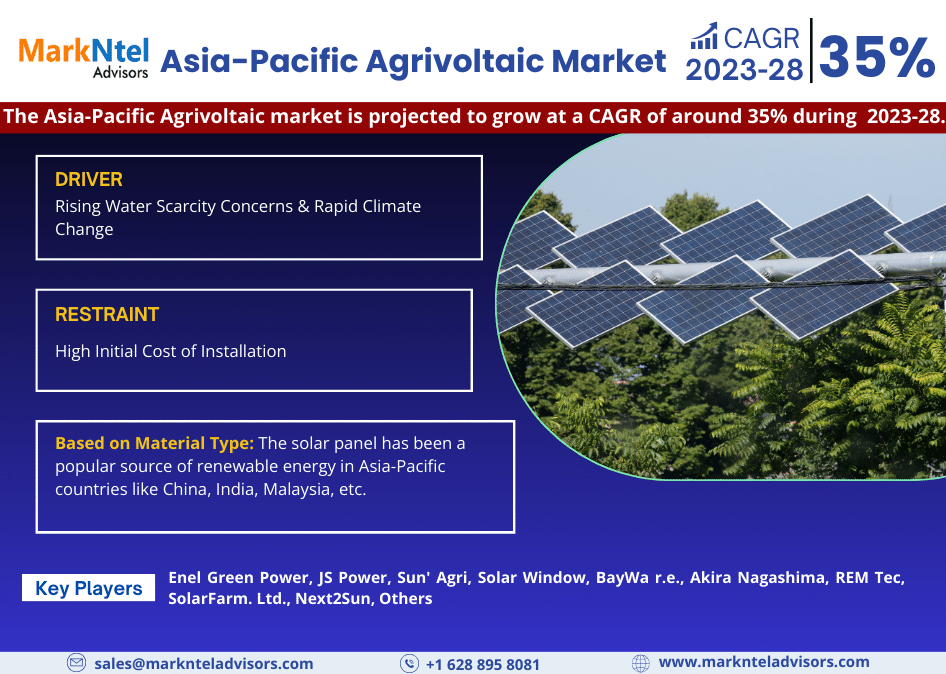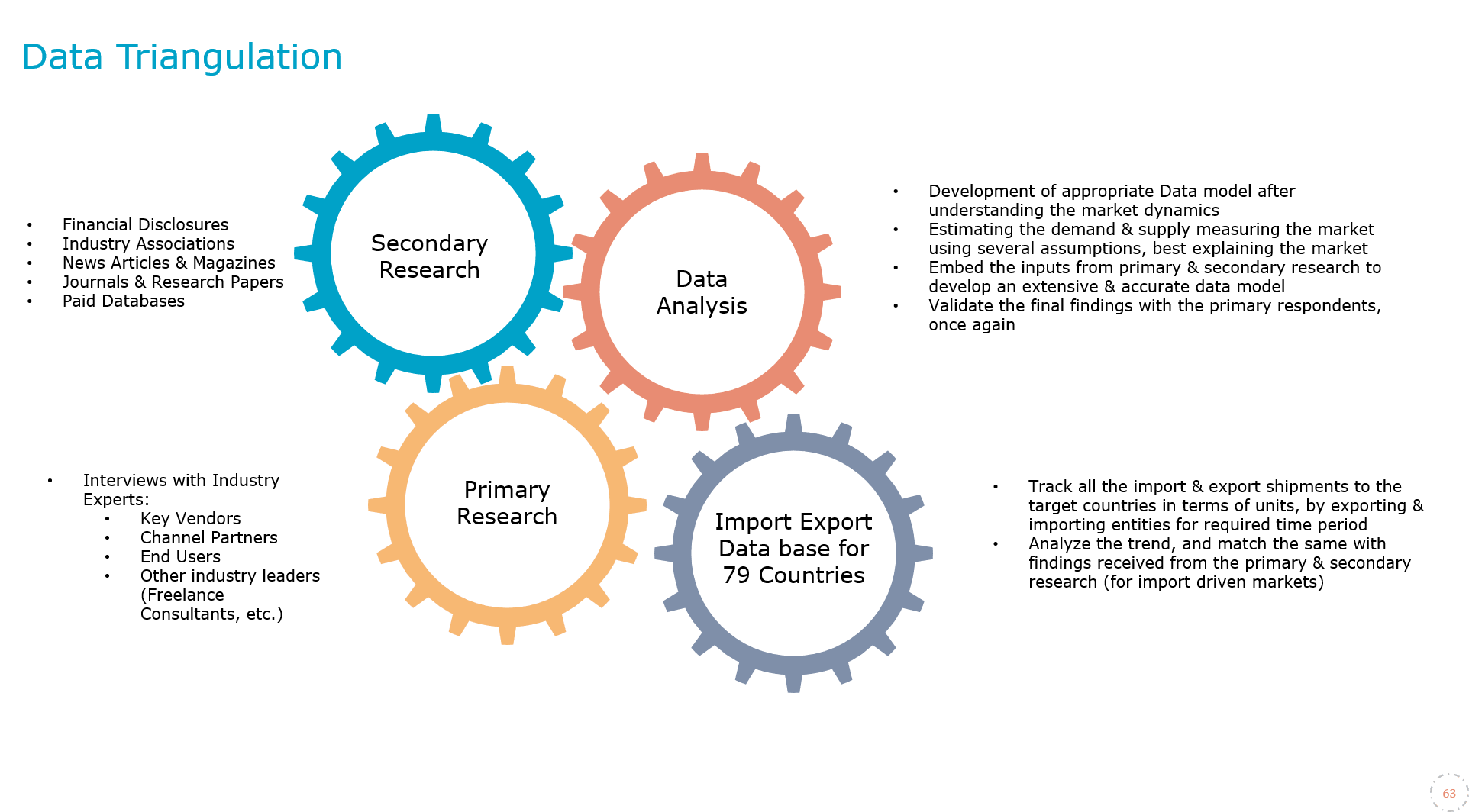
Asia-Pacific Agrivoltaic Market Research Report: Forecast (2023-2028)
By Placement (Standalone, Shading Nets, Greenhouse, Others), By Material Type (Panels, Paints), By Cell Type (Monocrystalline, Polycrystalline), By Crop Collaboration (Vegetables, ...Fruits, Crops, Others), By Type of Agrivoltaic Plant (Overhead Tilted, Interspace, Hybrid), By Type of Solar Panel (Opaque, Semi Transparent, Transparent), By Power Output (Upto 10 MWp, 10.1 to 50 MWp, More than 50 MWp), By Countries (China, India, South Korea, Japan, Australia, Southeast Asia, Rest of Asia-Pacific), By Company (Enel Green Power, JS Power, Sun' Agri, Solar Window, BayWa r.e., Akira Nagashima, REM Tec, SolarFarm. Ltd., Next2Sun, Others) Read more
- Environment
- Sep 2023
- Pages 157
- Report Format: PDF, Excel, PPT
Market Insights & Analysis: Asia-Pacific Agrivoltaic Market (2023-28)
The Asia-Pacific Agrivoltaic market is projected to grow at a CAGR of around 35% during the forecast period, i.e., 2023-28. The region has shown commendable growth for the market in the historical period, i.e., 2018-2022. Some of the factors that have contributed to the development have been the rising concerns about climate change, shifting electricity production from non-renewable sources to renewable sources, government initiatives to assist the adoption of this technology, etc.
The Asia-Pacific region has been a lucrative market presenting huge opportunities due to the vast availability of flatlands for agrarian activities, which could be potentially used for dual purposes, such as agriculture production as well as electricity generation. Countries such as China, India, Indonesia, Thailand, Vietnam, the Philippines, etc., have a high dependence on fossil fuels, due to which the region has been the major contributor of greenhouse gases.
| Report Coverage | Details |
|---|---|
| Study Period | Historical Data: 2018-21 |
| Base Year: 2022 | |
| Forecast Period: 2023-28 | |
| CAGR (2023-2028) | 35% |
| Countries Covered | China, India, South Korea, Japan, Australia, Southeast Asia, Rest of Asia-Pacific |
| Key Companies Profiled | Enel Green Power, JS Power, Sun' Agri, Solar Window, BayWa r.e., Akira Nagashima, REM Tec, SolarFarm. Ltd., Next2Sun, Others |
| Unit Denominations | USD Million/Billion |
With the enormous size of the population engaged in agricultural activities & the adoption of sustainable agriculture practices, the demand for these technological solutions in Asian countries would rise significantly in the forecast period. Furthermore, many of the key agrivoltaics projects have been announced in the regional countries that are indicators of the increasing adoption of these practices as well as would be conducive to the future growth of the market in the region. In 2021, Beijing Energy International Holding, a state-owned solar developing firm, revealed its plans to invest in a 112MW agriculture photovoltaics power project in China.

Asia-Pacific Agrivoltaic Market Driver:
Rising Water Scarcity Concerns & Rapid Climate Change - With the rapidly growing population of countries such as China, India, Pakistan, Indonesia etc., regional food production is expected to increase in the future. The rapid climate changes like rising temperature levels & reduced precipitation, coupled with mounting water scarcity concerns for agriculture sectors in the region, would surge the demand for agrivoltaics in future periods.
In addition, the shifting focus toward adopting this technology enables the effective use of sunlight for crop growth. Moreover, a grave effect of climate change has been faced by the farming sector in terms of either heavy rains or heat waves. Hence, the agrivoltaic industry offers several benefits in the agricultural sector & farmers' earnings from power generation & has positively influenced the overall market growth. For instance:
- In 2022, the Central Arid Zone Research Institute (CAZRI) launched a project 'Agrivoltaics,' in Northern India, as high temperatures have damaged farm crops & increased weeds, pests, and fungi. After the implementation of the new system, the farm has seen an upsurge in wheat tillers per square meter from under the solar panels as compared to the rest of the field.
Moreover, with the swift climate changes, consumers used water for agricultural purposes, and there would not be enough water to meet the booming food requirements in the future. Therefore, ascending water scarcity is one of the crucial challenges that could hinder the growing demand for food production. As a result, there is an extreme need for an effective solution like agrivoltaics that helps to meet the desired food demand by overcoming the challenge of water scarcity, thus influencing the market growth in the following years.
Asia-Pacific Agrivoltaic Market Possible Restraint:
High Initial Cost of Installation - The initial cost of installation of solar panels is very high compared to other renewable energy sources. Solar panels require inverters & storage batteries to convert direct current to alternating current to generate electricity. Installing a solar panel is cheap, but the setup of other equipment, such as energy batteries, is expensive. The average cost of a 1MW plant in India is approximately USD537,320, including 13.8% taxes. Therefore, extra expenses are incurred as additional insurance costs. In addition, the land space required to install solar plants with solar panels is vastly greater compared to other renewable energy sources. Solar panels require considerable maintenance as they are fragile & can easily be damaged.
Moreover, this includes paying for solar panels, inverters, batteries, wiring, and installation. Solar energy storage is expensive & around a 3-10kW solar system with a 5kWh battery size & cost is approximately USD6,684 or more & reduces consumers' power bills by at least 50%. These batteries are used in off-the-grid solar systems & are charged during the day so that the energy is used at night. Furthermore, as solar technologies are developing worldwide, it is assumed that prices would go down in the forecast years.
Asia-Pacific Agrivoltaic Market Key Trend:
Rising Collaboration Between Energy Companies - Agrivoltaics has been at the center of demand in the countries like China, South Korea, India, Japan, and other countries in the region. With the growing awareness among consumers, the technology providers have taken initiatives to collaborate with energy companies to boost market growth. As the strategic placement of solar panels above the crop growing area has the potential to offer positive outcomes in agriculture & helps to regulate the sunlight required by each plant so that they get sufficient sunlight for their maximum growth using minimum water.
Furthermore, the growing demand for clean energy sources & food contributed to the market growth. Hence, the adoption of agrivoltaics is an opportunity for farmers to generate extra income by selling solar power produced on their land to the power grids. In addition, the collaboration activities being done by the manufacturers would help to ensure sustainable farming practices.
Asia-Pacific Agrivoltaic Market (2023-28): Segmentation Analysis
The Asia-Pacific Agrivoltaic Market study of MarkNtel Advisors evaluates & highlights the major trends & influencing factors in each segment & includes predictions for the period 2023–28 at the regional, and national levels. In accordance to the analysis, the market has been further classified as:
Based on Material Type:
- Panels
- Paints
Panels have been the highlight of the market. The solar panel has been a popular source of renewable energy in Asia-Pacific countries like China, India, Malaysia, etc., where the majority share has been captured by solar panels over the past few years. Implying the substantial number of solar panels used to assemble the sets up across the globe. The surging development of agrivoltaic solar power plants with fixed solar panels across the region is expected to drive the segment growth.
Paints, being a relatively new technology, have a long way to ensure a significant foothold in the overall market. Solar Window, an American company, has reported around 1.8 million kWh of annual energy generated through this technology with the help of photovoltaic paints or liquid electricity. Hence, portraying a bright future with gradual progression for paints in the global market in the upcoming years.
Based on Cell Type:
- Monocrystalline
- Polycrystalline
Monocrystalline Photovoltaic (PV) cell modules have gained notable market share during the historical period, owing to the greater efficiency provided by the monocrystalline over polycrystalline PV cell modules. Observing the benefit of monocrystalline PV cell modules, companies like BayWa r.e., GroenLeven, and others have specifically designed & provided monocrystalline solar panels for multiple projects in the region. Polycrystalline PV cell modules are a bunch of silicone gel combined to form one. This method reduces the cost of production but also downsizes the efficiency of the PV panel. The lowered cost of the polycrystalline panel has been the main reason for their crucial share in the whole market.
Based on Crop Collaboration:
- Vegetables
- Fruits
- Crops
- Others (Herbs, etc.)
Here, Vegetables accounted for a sizeable demand for the deployment of agrivoltaics in the Asian region. The countries in the region, including India, China, Thailand, Vietnam, Bangladesh, South Korea, etc., have high levels of vegetable production & exports, for vegetables, such as potato, brinjal, cabbage, broccoli, onion, garlic, among others, due to which the implementation of this technology have been observed to be high, as compared to fruits. However, Thailand, India, and China are major producers of fruits, like apples, mango, oranges, cherries, grapes, etc., which have also witnessed an appreciable demand for this technology.
Asia-Pacific Agrivoltaic Market Regional Projection:
Geographically, the market expands across:
- China
- India
- South Korea
- Japan
- Australia
- Southeast Asia
- Rest of Asia-Pacific
Of all the countries across the region, China held a dominant position in the Asia-Pacific Agrivoltaics market during 2018-2022. China is one of the largest producers & consumers of food crops globally. However, challenges such as the growing need for food & energy due to a rapid increase in population, rising temperatures, the declining yield of crops, and water scarcity have contributed to the growing domestic & international concerns in both the energy & agriculture industries of the country.
Moreover, these challenges have driven the focus of both commercial investors & government on sustainable food & energy production, as its use in farmlands offers dual benefits to farmers, which further helps in increased agricultural output & also allows the farmers to earn from power generation. Additionally, China's 13th five-year plan (2016-2020) of 'Green production' further contributed to an upsurge in investment, partnerships, and agreements between private players, government firms, and commercial investors in agrivoltaics.
Asia-Pacific Agrivoltaic Industry Recent Developments
- In 2021, a Japan-based energy company, Renewable Japan announced to raise USD 92.42 million for a 25.76 MW of Agrivoltaics farm project in Kagoshima prefecture, Japan.
Gain a Competitive Edge with Our Asia-Pacific Agrivoltaic Market Report
- Asia-Pacific Agrivoltaic Market report provides a detailed and thorough analysis of market size, growth rate, competitive landscape, and key players. This comprehensive analysis helps businesses gain a holistic understanding of the market dynamics and make informed decisions.
- This report also highlights current market trends and future projections, allowing businesses to identify emerging opportunities and potential challenges. By understanding market forecasts, companies can align their strategies and stay ahead of the competition.
- Asia-Pacific Agrivoltaic Market report aids in assessing and mitigating risks associated with entering or operating in the market.
- The report would help in understanding market dynamics, regulatory frameworks, and potential challenges, businesses can develop strategies to minimize risks and optimize their operations.
Frequently Asked Questions
Asia-Pacific Agrivoltaic Market Research Report (2023-2028) - Table of Contents
- Market Segmentation
- Introduction
- Research Process
- Assumption
- Product Definition
- Executive Summary
- Asia-Pacific Solar Industry Outlook, 2023
- Asia-Pacific Agrivoltaic Market Key Strategic Developments 2018-2022
- Partnerships, Alliances & Collaborations
- Mergers & Acquisitions
- Consortiums & Industry Associations
- Asia-Pacific Agrivoltaic Market Trends & Development
- Asia-Pacific Agrivoltaic Market Dynamics
- Growth Drivers
- Challenges
- Asia-Pacific Agrivoltaic Market Hotspot and Opportunities
- Asia-Pacific Agrivoltaic Market Policies, Regulations, and Standards
- Asia-Pacific Agrivoltaic Market Outlook, 2018-2028F
- Market Size and Analysis
- By Revenues (USD Million)
- By Installed Capacity (MWp)
- Market Share and Analysis
- By Placement
- Standalone
- Shading Nets
- Greenhouse
- Others (Solar Fence, Solar Windows, etc.)
- By Material Type
- Panels
- Paints
- By Cell Type
- Monocrystalline
- Polycrystalline
- By Crop Collaboration
- Vegetables
- Fruits
- Crops
- Others (Herbs, etc.)
- By Type of Agrivoltaic Plant
- Overhead Tilted
- Interspace
- Hybrid
- By Type of Solar Panel
- Opaque
- Semi Transparent
- Transparent
- By Power Output
- Upto 10 MWp
- 10.1 to 50 MWp
- More than 50 MWp
- By Countries
- China
- India
- South Korea
- Japan
- Australia
- Southeast Asia
- Rest of Asia-Pacific
- By Company
- Competition Characteristics
- Market Share & Analysis
- By Placement
- Market Size and Analysis
- China Agrivoltaic Market Outlook, 2018-2028F
- Market Size & Analysis
- By Revenues (USD Million)
- By Installed Capacity (MWp)
- Market Share and Analysis
- By Placement
- By Material Type
- By Cell Type
- By Crop Collaboration
- By Type of Agrivoltaic Plant
- By Type of Solar Panel
- By Power Output
- Market Size & Analysis
- India Agrivoltaic Market Outlook, 2018-2028F
- Market Size & Analysis
- By Revenues (USD Million)
- By Installed Capacity (MWp)
- Market Share and Analysis
- By Placement
- By Material Type
- By Cell Type
- By Crop Collaboration
- By Type of Agrivoltaic Plant
- By Type of Solar Panel
- By Power Output
- Market Size & Analysis
- South Korea Agrivoltaic Market Outlook, 2018-2028F
- Market Size & Analysis
- By Revenues (USD Million)
- By Installed Capacity (MWp)
- Market Share and Analysis
- By Placement
- By Material Type
- By Cell Type
- By Crop Collaboration
- By Type of Agrivoltaic Plant
- By Type of Solar Panel
- By Power Output
- Market Size & Analysis
- Japan Agrivoltaic Market Outlook, 2018-2028F
- Market Size & Analysis
- By Revenues (USD Million)
- By Installed Capacity (MWp)
- Market Share and Analysis
- By Placement
- By Material Type
- By Cell Type
- By Crop Collaboration
- By Type of Agrivoltaic Plant
- By Type of Solar Panel
- By Power Output
- Market Size & Analysis
- Australia Agrivoltaic Market Outlook, 2018-2028F
- Market Size & Analysis
- By Revenues (USD Million)
- By Installed Capacity (MWp)
- Market Share and Analysis
- By Placement
- By Material Type
- By Cell Type
- By Crop Collaboration
- By Type of Agrivoltaic Plant
- By Type of Solar Panel
- By Power Output
- Market Size & Analysis
- South East Asia Agrivoltaic Market Outlook, 2018-2028F
- Market Size & Analysis
- By Revenues (USD Million)
- By Installed Capacity (MWp)
- Market Share and Analysis
- By Placement
- By Material Type
- By Cell Type
- By Crop Collaboration
- By Type of Agrivoltaic Plant
- By Type of Solar Panel
- By Power Output
- Market Size & Analysis
- Asia-Pacific Agrivoltaic Market Key Strategic Imperatives for Success and Growth
- Competitive Outlook
- Competition Matrix
- Material Type Portfolio
- Brand Specialization
- Target Markets
- Target Material Types
- Research & Development
- Strategic Alliances
- Strategic Initiatives
- Company Profiles (Business Description, Material Type Segments, Business Segments, Financials, Strategic Alliances/ Partnerships, Future Plans)
- Enel Green Power
- JS Power
- Sun' Agri
- Solar Window
- BayWa r.e.
- Akira Nagashima
- REM Tec
- SolarFarm. Ltd.
- Next2Sun
- Others
- Competition Matrix
- Disclaimer
MarkNtel Advisors follows a robust and iterative research methodology designed to ensure maximum accuracy and minimize deviation in market estimates and forecasts. Our approach combines both bottom-up and top-down techniques to effectively segment and quantify various aspects of the market. A consistent feature across all our research reports is data triangulation, which examines the market from three distinct perspectives to validate findings. Key components of our research process include:
1. Scope & Research Design At the outset, MarkNtel Advisors define the research objectives and formulate pertinent questions. This phase involves determining the type of research—qualitative or quantitative—and designing a methodology that outlines data collection methods, target demographics, and analytical tools. They also establish timelines and budgets to ensure the research aligns with client goals.
2. Sample Selection and Data Collection In this stage, the firm identifies the target audience and determines the appropriate sample size to ensure representativeness. They employ various sampling methods, such as random or stratified sampling, based on the research objectives. Data collection is carried out using tools like surveys, interviews, and observations, ensuring the gathered data is reliable and relevant.
3. Data Analysis and Validation Once data is collected, MarkNtel Advisors undertake a rigorous analysis process. This includes cleaning the data to remove inconsistencies, employing statistical software for quantitative analysis, and thematic analysis for qualitative data. Validation steps are taken to ensure the accuracy and reliability of the findings, minimizing biases and errors.

4. Data Forecast and FinalizationThe final phase involves forecasting future market trends based on the analyzed data. MarkNtel Advisors utilize predictive modeling and time series analysis to anticipate market behaviors. The insights are then compiled into comprehensive reports, featuring visual aids like charts and graphs, and include strategic recommendations to inform client decision-making









